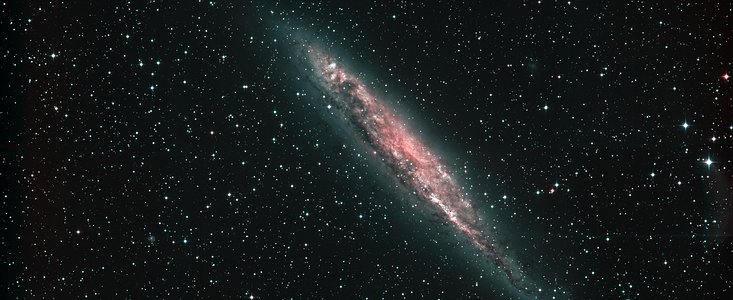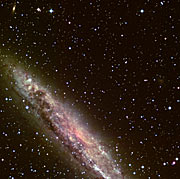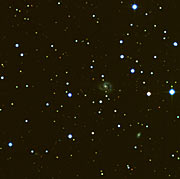Lehdistötiedote
First Colour Photo from ESO's Wide-Field-Imager at La Silla
Portrait of a Nearby Spiral Galaxy
26. maaliskuuta 1999
The portrait of NGC 4945 above adorns the centrefold of the most recent issue of the ESO Messenger (no. 95; March 1999). It provides another impressive demonstration of the observational capabilities of the new WFI Camera at the MPG/ESO 2.2-m telescope at La Silla.
The portrait of NGC 4945 above adorns the centrefold of the most recent issue of the ESO Messenger (no. 95; March 1999). It provides another impressive demonstration of the observational capabilities of the new WFI Camera at the MPG/ESO 2.2-m telescope at La Silla.
NGC 4945 is a relatively nearby spiral galaxy, not too different from the Milky Way Galaxy in which we live. However, since it happens to be seen almost edge-on (under an angle of about 10°), the spiral structure is hardly discernible. This particular perspective is essentially the same as the inside-view we have of the Milky Way, because our Solar System is located near its central plane. The distance from the Sun to the centre is about 30,000 light-years, or 2/3 of the radius of the Milky Way galaxy.
In both galaxies, the interstellar gas (that emits its own light and also reflects the stellar light) and dust (that absorbs the stellar light), imprint a high-contrast structure on the much smoother distribution of their hundreds of billions of stars. Most of the light recorded in the photo of NGC 4945 is from stars, while the dark lanes are areas where the dust blocks the light. The patchy and filamentary appearance of the interstellar matter indicates that it is a very dynamical medium.
In those regions, where the density is sufficiently large, self-gravitation causes clouds of dust and gas to contract to the point where new stars will begin to form. This process takes hundreds of thousands to millions of years. In galaxies like these, the equivalent of about one solar mass is transformed into new stars every year.
In NGC 4945 , observations at X-ray and infrared wavelengths have found evidence of very energetic processes in the nucleus (which is of the so-called Seyfert 2 type and may harbour a black hole ) and a major burst of star formation takes place in its vicinity.
NGC 4945 belongs to the Centaurus group of galaxies, seen in the constellation of that name and located at a distance of approximately 13 million light-years. This is only six times the distance to the 6th magnitude Andromeda Galaxy , the large galaxy in the northern sky that is visible to the unaided eye and is the most prominent member of the Local Group of Galaxies. NGC 4945 (9th magnitude; i.e. 15 times fainter) is thus a rather nearby object. Its velocity with respect to the Milky Way is comparatively small, 560 km/sec, and is not governed by the expansion of the Universe but reflects the local motions of the two galaxies.
Tiedotteesta
| Tiedote nr.: | eso9922 |
| Legacy ID: | Photo 18a-d/99 |
| Nimi: | NGC 4945 |
| Tyyppi: | Local Universe : Galaxy : Type : Spiral |
| Facility: | MPG/ESO 2.2-metre telescope |
| Instruments: | WFI |
Our use of Cookies
We use cookies that are essential for accessing our websites and using our services. We also use cookies to analyse, measure and improve our websites’ performance, to enable content sharing via social media and to display media content hosted on third-party platforms.
ESO Cookies Policy
The European Organisation for Astronomical Research in the Southern Hemisphere (ESO) is the pre-eminent intergovernmental science and technology organisation in astronomy. It carries out an ambitious programme focused on the design, construction and operation of powerful ground-based observing facilities for astronomy.
This Cookies Policy is intended to provide clarity by outlining the cookies used on the ESO public websites, their functions, the options you have for controlling them, and the ways you can contact us for additional details.
What are cookies?
Cookies are small pieces of data stored on your device by websites you visit. They serve various purposes, such as remembering login credentials and preferences and enhance your browsing experience.
Categories of cookies we use
Essential cookies (always active): These cookies are strictly necessary for the proper functioning of our website. Without these cookies, the website cannot operate correctly, and certain services, such as logging in or accessing secure areas, may not be available; because they are essential for the website’s operation, they cannot be disabled.
Functional Cookies: These cookies enhance your browsing experience by enabling additional features and personalization, such as remembering your preferences and settings. While not strictly necessary for the website to function, they improve usability and convenience; these cookies are only placed if you provide your consent.
Analytics cookies: These cookies collect information about how visitors interact with our website, such as which pages are visited most often and how users navigate the site. This data helps us improve website performance, optimize content, and enhance the user experience; these cookies are only placed if you provide your consent. We use the following analytics cookies.
Matomo Cookies:
This website uses Matomo (formerly Piwik), an open source software which enables the statistical analysis of website visits. Matomo uses cookies (text files) which are saved on your computer and which allow us to analyze how you use our website. The website user information generated by the cookies will only be saved on the servers of our IT Department. We use this information to analyze www.eso.org visits and to prepare reports on website activities. These data will not be disclosed to third parties.
On behalf of ESO, Matomo will use this information for the purpose of evaluating your use of the website, compiling reports on website activity and providing other services relating to website activity and internet usage.
Matomo cookies settings:
Additional Third-party cookies on ESO websites: some of our pages display content from external providers, e.g. YouTube.
Such third-party services are outside of ESO control and may, at any time, change their terms of service, use of cookies, etc.
YouTube: Some videos on the ESO website are embedded from ESO’s official YouTube channel. We have enabled YouTube’s privacy-enhanced mode, meaning that no cookies are set unless the user actively clicks on the video to play it. Additionally, in this mode, YouTube does not store any personally identifiable cookie data for embedded video playbacks. For more details, please refer to YouTube’s embedding videos information page.
Cookies can also be classified based on the following elements.
Regarding the domain, there are:
- First-party cookies, set by the website you are currently visiting. They are stored by the same domain that you are browsing and are used to enhance your experience on that site;
- Third-party cookies, set by a domain other than the one you are currently visiting.
As for their duration, cookies can be:
- Browser-session cookies, which are deleted when the user closes the browser;
- Stored cookies, which stay on the user's device for a predetermined period of time.
How to manage cookies
Cookie settings: You can modify your cookie choices for the ESO webpages at any time by clicking on the link Cookie settings at the bottom of any page.
In your browser: If you wish to delete cookies or instruct your browser to delete or block cookies by default, please visit the help pages of your browser:
Please be aware that if you delete or decline cookies, certain functionalities of our website may be not be available and your browsing experience may be affected.
You can set most browsers to prevent any cookies being placed on your device, but you may then have to manually adjust some preferences every time you visit a site/page. And some services and functionalities may not work properly at all (e.g. profile logging-in, shop check out).
Updates to the ESO Cookies Policy
The ESO Cookies Policy may be subject to future updates, which will be made available on this page.
Additional information
For any queries related to cookies, please contact: pdprATesoDOTorg.
As ESO public webpages are managed by our Department of Communication, your questions will be dealt with the support of the said Department.




